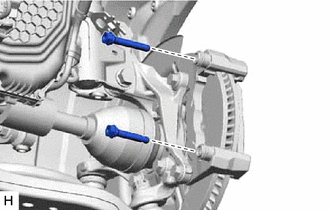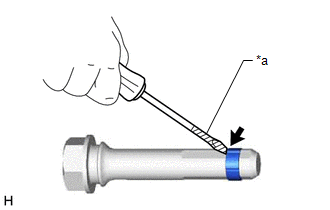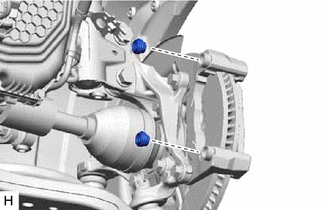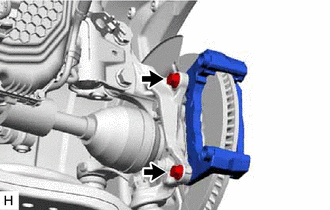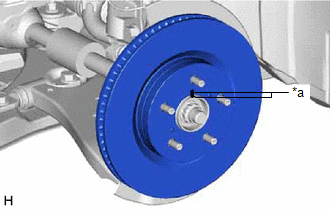Lexus ES: Removal
REMOVAL
CAUTION / NOTICE / HINT
The necessary procedures (adjustment, calibration, initialization, or registration) that must be performed after parts are removed and installed, or replaced during front brake removal/installation are shown below.
Necessary Procedures After Parts Removed/Installed/Replaced (for HV Model)| Replaced Part or Performed Procedure | Necessary Procedure | Effect/Inoperative Function when Necessary Procedure not Performed | Link |
|---|---|---|---|
|
*: When performing learning using the Techstream.
Click here | |||
| Auxiliary battery terminal is disconnected/reconnected | Perform steering sensor zero point calibration | Lane Control System (for HV Model) | |
| Pre-collision System (for HV Model) | |||
| Parking Support Brake System (for HV Model)* | |||
| Lighting System (for HV Model) | |||
| Memorize steering angle neutral point | Parking Assist Monitor System (for HV Model) | | |
| Panoramic View Monitor System (for HV Model) | | ||
| Initialize power trunk lid system | Power Trunk Lid System (for HV Model) | | |
NOTICE:
- Immediately after installing the brake pads, the braking performance may be reduced. Always perform a road test in a safe place while paying attention to the surroundings.
- After replacing the front disc brake pads, the brake pedal may feel soft due to clearance between the front disc brake pads and front disc. Depress the brake pedal several times until the brake pedal feels firm.
- After replacing the front disc brake pads, always perform a road test to check the braking performance and check for vibrations.
- When the brake pedal is first depressed after replacing the brake pads or pushing back the disc brake piston, DTC C1214 may be stored. As there is no malfunction, clear the DTC. (for HV Model)
- While the auxiliary battery is connected, even if the power switch is off, the brake control system activates when the brake pedal is depressed or any door courtesy switch turns on. Therefore, when servicing the brake system components, do not operate the brake pedal or open/close the doors while the auxiliary battery is connected. (for HV Model)
- After the power switch is turned off, the radio receiver assembly records various types of memory and settings. As a result, after turning the power switch off, make sure to wait at least 85 seconds before disconnecting the cable from the negative (-) auxiliary battery terminal. (for HV Model Audio and Visual System)
- After the power switch is turned off, the radio receiver assembly records various types of memory and settings. As a result, after turning the power switch off, make sure to wait at least 85 seconds before disconnecting the cable from the negative (-) auxiliary battery terminal. (for HV Model Navigation System)
HINT:
- Use the same procedure for the RH side and LH side.
- The following procedure is for the LH side.
PROCEDURE
1. PRECAUTION (for HV Model)
NOTICE:
After turning the power switch off, waiting time may be required before disconnecting the cable from the negative (-) auxiliary battery terminal. Therefore, make sure to read the disconnecting the cable from the negative (-) auxiliary battery terminal notices before proceeding with work.
2. DISABLE BRAKE CONTROL (for HV Model)
(a) Wait at least 2 minutes after turning the power switch off.
NOTICE:
When the brake pedal is depressed or the door courtesy switch is turned on even if the power switch is off, the brake control system activates. Therefore do not depress the brake pedal or open/close the doors until the reservoir level switch connector is disconnected.
(b) Disconnect the reservoir level switch connector.
(c) Disconnect the cable from the negative (-) auxiliary battery terminal.
Click here .gif)
(d) Depress the brake pedal 40 times or more to return all the fluid in the accumulator back to the reservoir.
(e) Check that the brake pedal cannot be further depressed.
3. REMOVE FRONT WHEEL
Click here .gif)
4. DRAIN BRAKE FLUID
NOTICE:
If brake fluid leaks onto any painted surface, immediately wash it off.
5. DISCONNECT FRONT FLEXIBLE HOSE
| (a) Remove the union bolt and gasket, and disconnect the front flexible hose from the front disc brake cylinder assembly. |
|
6. REMOVE FRONT DISC BRAKE CYLINDER ASSEMBLY
| (a) Hold the 2 front disc brake cylinder slide pins and remove the 2 bolts and front disc brake cylinder assembly. |
|
7. REMOVE FRONT DISC BRAKE PAD
| (a) Remove the 2 front disc brake pads from the front disc brake cylinder mounting. |
|
8. REMOVE FRONT DISC BRAKE ANTI-SQUEAL SHIM KIT
Click here .gif)
9. REMOVE FRONT DISC BRAKE PAD SUPPORT PLATE
| (a) Remove the 4 front disc brake pad support plates from the front disc brake cylinder mounting. NOTICE: Each front disc brake pad support plate has a different shape. Be sure to put an identification mark on each front disc brake pad support plate so that it can be reinstalled to its original position. |
|
10. REMOVE FRONT DISC BRAKE CYLINDER SLIDE PIN
| (a) Remove the 2 front disc brake cylinder slide pins from the front disc brake cylinder mounting. |
|
| (b) Using a screwdriver with its tip wrapped with protective tape, remove the front disc brake cylinder slide bushing from the front disc brake cylinder slide pin (lower side). NOTICE: Do not damage the front disc brake cylinder slide pin. |
|
11. REMOVE FRONT DISC BRAKE BUSHING DUST BOOT
| (a) Remove the 2 front disc brake bushing dust boots from the front disc brake cylinder mounting. |
|
12. REMOVE FRONT DISC BRAKE CYLINDER MOUNTING
| (a) Remove the 2 bolts and front disc brake cylinder mounting from the steering knuckle. |
|
13. REMOVE FRONT DISC
| (a) Put matchmarks on the front disc and the front axle hub sub-assembly. |
|
(b) Remove the front disc.

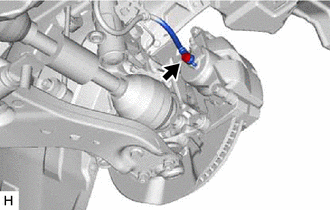
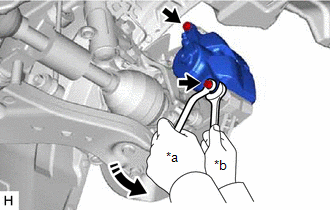
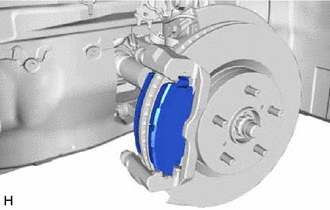
.png)
